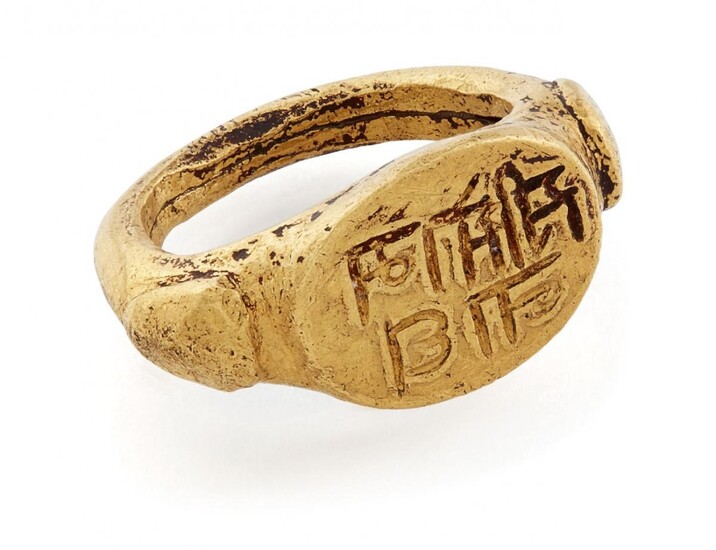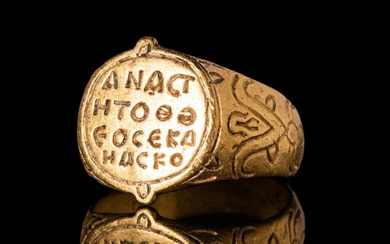A very rare early gold ring inscribed "Sri Somanath" (Lord Shiva), South India, 10th-11th century, with raised triangular elements to shoulders, the flat oval bezel inscribed and filled with black substance to enhance the inscription, the band...
A very rare early gold ring inscribed "Sri Somanath" (Lord Shiva), South India, 10th-11th century, with raised triangular elements to shoulders, the flat oval bezel inscribed and filled with black substance to enhance the inscription, the band plain, 2.3cm. diam., weight 10.2 grams The Somnath temple (also known as the Deo Patan) located in Veraval in Saurashtra on the western coast of Gujarat, India is believed to be the first among the twelve Jyotirlinga shrines of Shiva. It is an important pilgrimage site. Somnath’s first temple is said to have existed 2000 years ago. Is. In 649 AD, King Maitre of Vallabhini built a new temple in place of the original temple and renovated the site. In 725, the old ruler of Sindh took his army and attacked the temple and destroyed the compound. Pratishtha King Nag Bhatt II reconstructed the temple for the third time in 815 using a red stone (sandstone). In 1026, Mahmud Ghazni looted the precious jewels and property of Somnath temple, slaughtering innumerable pilgrims and burning the temple. Between 1026-1042AD, Solanki Raja Bhimdev built the fourth temple of Bhoj and Anhilwad Patan, Parmar King of Malwa. Somnath was destroyed a fifth time when the Delhi Sultanate occupied Gujarat in 1299. In 1394 it was destroyed again and in 1706 eventually rebuilt again by Mughal ruler Aurangzeb. Somnath means "Lord of the Soma", an epithet of Lord Shiva
[ translate ]View it on
Sale price
Estimate
Reserve
Time, Location
Auction House
A very rare early gold ring inscribed "Sri Somanath" (Lord Shiva), South India, 10th-11th century, with raised triangular elements to shoulders, the flat oval bezel inscribed and filled with black substance to enhance the inscription, the band plain, 2.3cm. diam., weight 10.2 grams The Somnath temple (also known as the Deo Patan) located in Veraval in Saurashtra on the western coast of Gujarat, India is believed to be the first among the twelve Jyotirlinga shrines of Shiva. It is an important pilgrimage site. Somnath’s first temple is said to have existed 2000 years ago. Is. In 649 AD, King Maitre of Vallabhini built a new temple in place of the original temple and renovated the site. In 725, the old ruler of Sindh took his army and attacked the temple and destroyed the compound. Pratishtha King Nag Bhatt II reconstructed the temple for the third time in 815 using a red stone (sandstone). In 1026, Mahmud Ghazni looted the precious jewels and property of Somnath temple, slaughtering innumerable pilgrims and burning the temple. Between 1026-1042AD, Solanki Raja Bhimdev built the fourth temple of Bhoj and Anhilwad Patan, Parmar King of Malwa. Somnath was destroyed a fifth time when the Delhi Sultanate occupied Gujarat in 1299. In 1394 it was destroyed again and in 1706 eventually rebuilt again by Mughal ruler Aurangzeb. Somnath means "Lord of the Soma", an epithet of Lord Shiva
[ translate ]



